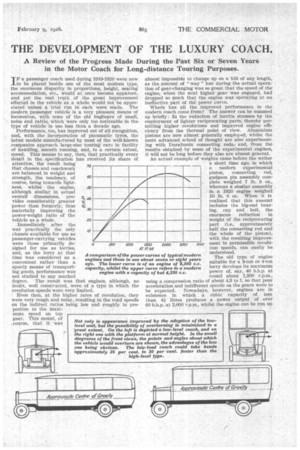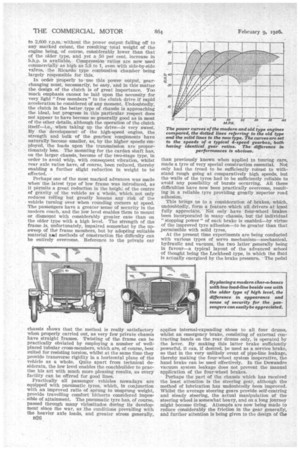THE DEVELOPMENT OF THE LUXURY COACH.
Page 9

Page 10

Page 11

If you've noticed an error in this article please click here to report it so we can fix it.
A Review of the Progress Made During the Past Six or Seven Years in the Motor Coach for Long-distance Touring Purposes.
IF a passenger coach used during 1919-1920 were now to be placed beside one of the most modern type, the enormous disparity in proportions, height, seating accommodation, etc., would at once become apparent, and yet the real truth of the great improvement effected in the vehicle as a whole would not be appreciated unless a trial run in each were made. The modern passenger vehicle is a very pleasant means of locomotion, with none of the old bugbears of smell, noise and rattle, which were only too noticeable in the type of vehicle in use less than a decade ago.
Performance, too, has improved out of all recognition, and, with the incorporation of pneumatic tyres, the latest models manufactured by most of the well-known • companies approach large-size touring cam in facility of handling, smooth running, and, to a certain extent, speed. This means to say, then, that practically every detail in the specification has received its share of attention, the result -being that chassis and coachwork are balanced in weight and strength, the tendency, of course, being towards lightness, whilst the engine, althOugh similar in actual overall dimensions, provides considerably greater power than formerly, thus materially improving the power-weight ratio of the vehicle as a whole.
Immediately after the war practically the only chassis available for use as passenger-carrying vehicles were those primarily designed for use as lorries, and, as the lorry at that time was considered as a convenient rather than a speedy means of transporting goods, performance was not studied to any marked degree. The result was that engines, although, no doubt, well constructed, were of a type in which the revolution speeds were very limited.
Even then, at the higher rates of revolution, they were very rough and noisy, resulting in the road speeds on the indirect ratios being low and roughly in proportion to the maxi mum speed on top r
70
50
50
4. 40
Crj 30 20
almost impossible to change up on a hill of any length, as the amount of " way " lost during the actual operation of gear-changing was so great that the speed of the' engine, when the next higher gear was engaged, had dropped so much that the engine was operating at an ineffective part of the power curve.
Where has all the improved performance in the modern coach come from? The answer can be summed up briefly : In the reduction of inertia stresses by the employment of lighter reciprocating parts, thereby permitting higher revolutions and improved engine efficiency from the thermal point of view. Aluminium pistons are now almost generally employed, whilst the more advanced school of thought are also' experiment,ing with. Duralumin connecting rods? and, from the results obtained by some of the experimental engines, it will not be long before they also are almost general.
An actual example of weights came before the writer a short time ago, in which a modern experimental piston, connecting rod, gudgeon pin assembly complete weighed 7 lb. 9 oz., whereas a similar assembly , in a 1920 engine weighed 10 lb. 6 oz. When it is realized that this amount includes the big-end bearing, cap and bolt, the enormous reduction in weight of the reciprocating part (i.e., approximately half the connecting rod and the whole of the piston), with the resulting improvement in permissible revolution speeds, can easily be understood.
The old type of engine suitable for a 3-ton or 4-ton lorry develops its maximum power of, say, 40 b.h.p. at round about 1,300 r.p.m., using a compression ratio of about 4.3 to 1, so that poor acceleration and indifferent speeds on the gears were to be expected. Nowadays, however, engines are in existence in which a athic capacity of less than 4i litres produces a power output of over 60 b.h.p. at 2,000 r.p.m., whilst the engine can be run up
500 /000 1500 2000 250C 3000 RPM
to 2,600 r.p.m. without the power output falling off to any marked extent, the resulting total weight of the engine being, of course, considerably lower than that of the older type, and yet a 50 per cent, increase in b.h.p. is available. Compression ratios are now used commercially as high as 5.9 to 1, even with side-by-side valves, the Ricardo type combustion chamber being largely responsible for this.
In order prope0Y to use this power output, gearchanging must, necessarily, be easy, and in this matter the design of the clutch is of great importance. Too much emphasis cannot be laid upon the necessity for very light "free members" to the clutch drive if rapid acceleration be considered of any moment. Undoubtedly, the clutch in the better type of chassis is approaching the ideal, but progress in this particular respect does not appear to have become so generally good as in most of the other details, although the operation of the clutch itself—i.e., when taking up the drive—is very sweet. By the development of the high-speed engine, the strength and bulk of the gearbox -comPonents have naturally become smaller, as, by the higher speeds employed, the loads upon the tra-nsmission are proportionately less. The mounting for the cardan shaft has, on the larger chassis, become of the two-stage type, in order to avoid whip, with consequent vibration, whilst rear axle ratios have, of course, been reduced, thereby enabling a further slight reduction in weight to be effected.
Perhaps one of the most marked advances was made when the latest type of low frame was introduced, as it permits a great reduction in the height of the centre of gravity of the vehicle as a whole, which not only reduces rolling but greatly lessens any risk of the vehicle turning over when rounding corners at speed. The passengers have a greater sense of security in the modern coach, and the low level enables them to mount or dismount with considerably greater ease than on the older type with a high level. The strength of the frame is, unfortunately, impaired somewhat by the upsweep of the, frame members, but by adopting suitable material aad methods of construction the difficulty can be entirely overcome. Reference to the private car chassis shows that the method is really satisfactory when properly carried out, as very few private chassis have straight frames. Twisting of the frame can be practically obviated by employing a number of wellplaced tubular cross-members, which are, of course, best suited for resisting torsion, whilst at the same time they provide transverse rigidity in a horizontal plane of the vehicle as a whole. Quite apart from technical desiderata, the low level enables the coachbuilder to practise his art with much more pleasing results, as every facility can be offered for good lines.
Practically all passenger vehicles nowadays are equipped with pneumatic tyres, which, in conjunction with an improved ratio of sprung to unsprung weight, provide travelling comfort hitherto considered impossible of attainment. The pneumatic tyre has, of course, passed through many vicissitudes during its development since the war, as the conditions prevailing with the heavier axle loads, and greater stress generally, D26 than previously known when applied to touring cars, made a tyre of very special construction essential. Not only had the tread to be sufficiently robust to withstand rough going at comparatively high speeds, but the walls of the tyres had to be sufficiently reliable to avoid any possibility of bursts occurring. All these difficulties have now been practically overcome, resulting in a reliable tyre providing greatly superior road adhesion.
This brings us to a consideration of brakes, which, undoubtedly, form a feature Which all drivers at least fully appreciate, Not only have four-wheel brakesbeen incorporated in many chassis, but the individual "stopping power" of each brake is enabled—by virtue of the improved tyre adhesion—to be greater than that .permissible with solid tyres.
At the present time experiments are being conducted with various types of servo mechanism—mechanical, hydraulic and vacuum, the two latter generally being in favour—a typical layout of the advanced school of thought being the Lockheed type, in which the fluid is actually energized by the brake pressure. The pedal
applies internal-expanding shoes to all four drums, whilst an emergency brake, consisting of external contracting bands on the rear drums only, is operated by the lever. By making this latter brake sufficiently powerful, it can, if desired, be used as a service brake, so that in the very unlikely event of pipe-line leakage, thereby making the four-wheel system inoperative, the hand brake can be used effectively. In the Dewandre vacuum system leakage does not prevent the manual application of the four-wheel brakes.
Perhaps the part of the chassis which has received the least attention is the steering gear, although the method of lubrication has undoubtedly been improved. Whilst the average steering gears provide self-centring and steady steering, the actual manipulation of the steering wheel is somewhat heavy, and on a long journey might become tiring. Attempts are now being made to reduce considerably the friction in the gear generally, and further attention ls being given to the design of the axle and pivots in such a way as to reduce the effort required to move the wheels.
All coaches of the large type are now being fitted with a very complete electrical equipment. Not only are the head and side lights of similar dimensions and lighting capacity to those employed on the better type of touring car, but interior lighting has received its share of attention, whilst starter-motors are often to be found in the specification. Storage batteries and dynamos are larger than was hitherto considered necessary, and with the increase in size they have provided a means whereby the extra current required by the interior lights and starter-motor can be maintained for long periods without running down the. battery. Whether electric heaters will be provided in future remains an open question, but a supercoach has already made its appearance with a gas stove for heating water to provide tea while travelling, so the more universal ' application of electric appliances may not be very far distant.
In recording the advances made in bus and coach bodywork, a glance at the accompanying illustrations will instantly convey the enormous improvement in appearance of the exterior and in the comfort and general air of luxury of the interior. Seating accommodation, whilst more or less on conventional lines, nowadays provides roominess and freedom from restriction ; in addition, cushions and squabs placed at angles allow the passenger to adopt the attitude of reclining if desired. In some coaches the seats aPe of the armchair type, and in at least one instance folding tables which can be raised and lowered at will are formed in the backs of each seat, whilst racks are provided, also a standard form of suitcase, for the accommodation of which special lockers are provided at each side of the coach.
All fittings such as windows and doors have gradually been improved in detail construction, and the best examples now do not obtrude upon the nerves of the most fastidious passenger, special precaution being taken against rattle, which, combined with more scientific, and therefore rigid, construction of the coachwork generally, provides travel equal in many ways to the high-grade private car.
Sid screens, higher body sides, wider doors and Improved suspension, largely made possible by the use of pneumatic tyres, haye made the motor coach a distinct advance on its prototype, and doubtless, as the modern types become more universally adopted, the touring coach will become increasingly popular, and may even challenge for popularity the private car for longdistance touring.


























































